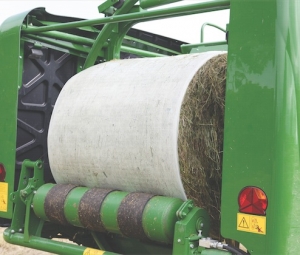Power Farming distributes Irish-made McHale balers in New Zealand, its machinery division general manager Graeme Leigh saying the new McHale Fusion 3 Plus baler allows wide polythene film, rather than netwrap, to secure silage bales before sealing with bale wrap.
The technique is referred to as film-on-film wrapping.
“One of the options for net replacement is Baletite [made by Minster Films] specifically for film-on-film wrapping,” Leigh says. “Baletite has been around for three years and test results show it produces better quality baleage than that made with netwrap.”
In 2013 Minster Films commissioned Dr Dave Davies, formerly of the UK’s Institute of Grassland and Environmental Research and now a consultant, to run a farm trial to test the quality of the silage produced using Baletite instead of netwrap.
Davies oversaw the production of 44 silage bales from one field of grass cut, wilted for 24 hours then baled using a McHale Fusion 3 Plus fitted to apply either netwrap or Baletite.
To ensure similar grass was ensiled in each treatment, chamber wrapping alternated between netwrap and Baletite every eight bales.
In February 2014, 206 days after ensiling, 12 bales from each treatment were opened and assessed for silage quality using: a pressure test to see how quickly the vacuum in a bale returned to normal atmospheric levels; mould assessment, i.e. weighing all the mould in a bale to assess the percentage of the bale affected; and silage analysis by taking a core sample from each bale.
The pressure test showed that the vacuum in Baletite bales took 180 seconds to dissipate compared to the vacuum in the netwrap bales which took 20 seconds, indicating a much better seal for the Baletite bales.
The Baletite bales had a much lower mean mould weight per bale at 5.5kg fresh matter (FM) compared to 23.9kg FM for the netwrap bales.
The total silage lost, which includes storage losses plus mould losses, showed the netwrap bales lost on average twice as much DM as the Baletite treatment.
The chemical analyses of the silage by the laboratory indicated the Baletite treated bales had better quality silage.
The Baletite bales had a higher DM than the netwrap bales, and the Baletite silage had higher sugar levels (89gm/kgDM vs 70g/kgDM for netwrap silage). Baletite silage also had a lower pH (4.46 vs 4.52 for netwrap silage).
The results showed lower levels of ammonia-N in the Baletite bales compared to the netwrap bales. Ammonia-N concentration in silage provides a gauge of protein breakdown: the lower the level the less protein has been degraded.
Summary figures show the film-on-film bales had: 7.5% lower DM losses than netwrap bales thanks to better fermentation; 80% lower DM losses than netwrap bales through mould; and 52% lower total DM losses than netwrap bales.
“If these results are translated into outcomes for dairy farmers, film-on-film bales would give an average of 7.35kg more DM per bale than netwrap,” Leigh says.
“If you follow this to its logical conclusion, 1.0kg DM equals 11.8 mega joules of metabolisable energy (MJ ME). This means the farmer gained 86.7 MJ ME per film-on-film bale.
“Given that it takes about 5.8 MJ ME to produce one litre of milk, the additional 86.7 MJ ME in each film-on-film bale could produce an additional 15 litres of milk.”
Davies says the Baletite bales in the farm trial showed better silage fermentation and lower losses than the netwrap treated bales.
This can be explained by the fact that Baletite net replacement film is tensioned onto the bale in the bale chamber, forcing air out of the bale to promote faster fermentation in the early stages while maintaining a more oxygen-free environment during the time the bales are in storage.
Film-on-film wrapping also enables automation of the feeding process and easier recycling after use.
Leigh say last year 70% of the fixed chamber McHale Fusion 3 baler-wrappers Power Farming sold in New Zealand were film-on-film machines and he expects the percentage to be 90% this year.
“People are seeing benefits. Feedback from farmers has been extremely positive and this is reflected in the sales we have had this year.”
Tel. 07 902 2200
www.powerfarming.co.nz
















